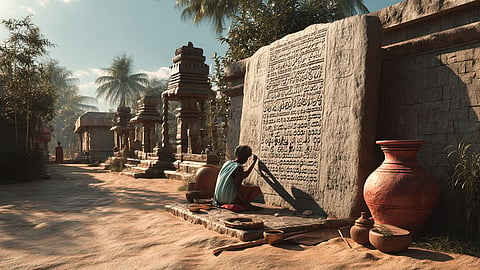- Commentary
- History Vignettes
- Notes on Culture
- Dispatches
- Podcasts
- Indian LanguagesIndian Languages
- Support

LONG-TIME READERS of The Dharma Dispatch are familiar with my fanatical obsession with inscriptions as the infallible guides to our history. Inscriptions are the physical artifacts of our historical memory and they should be preserved if as Hindus we truly care about having a civilisational future.
Inscriptions are also the raw materials which, after careful sifting and analysis, find their way into our textbooks and popular histories. Thus, if your average man on the street confidently talks about the awesome system of local self-governance in the medieval Tamil Desham, he bases it on the authority of the fabled Uttaramerur inscription dating back to the 10th century CE.
In all the discussions about inscriptions, an ancillary aspect is often overlooked if not altogether ignored. This is the role played by the inscription-makers. They are the unknown, unsung heroes, the scribes, historians, chroniclers and engravers who composed and etched the stories of our past on stone and metal and bark and leaf combining linguistic prowess and artistic finesse.
The last line of every inscription is signed off by the name of its engraver and in some cases, the engraver’s lineage is also briefly mentioned. It also mentions the name of the ruler, the person who wrote the text of the inscription, the purpose of the inscription and its exact city or village.
This essay series pays homage to the rather profound role that these scribes and engravers have played almost since the dawn of the Hindu civilisation.
Since the time of Kautilya, there was a separate office that issued inscriptions. The Arthasastra has a chapter giving elaborate guidelines for composing Sasanas or inscriptions. He lays special emphasis on linguistic eloquence, exactitude, clarity, etiquette and elegant handwriting. In fact, writing Sasanas eventually evolved as a separate science and art form and became a highly lucrative profession as we shall see. A remarkable 14th century Sanskrit inscription found near Anantapur gives an elaborate tutorial on how to write the perfect Śāsana-padya. A Śāsana is typically a mixture of prose and poetry.
The chief of the Śāsana department commanded a powerful influence in the kingdom. He was called as the Śāsanācārya or Rāya sūtradhāri and the engraver under him was known as the Shilpi. He directed and supervised the writing of Śāsanas and sometimes, personally wrote them.
For the purposes of this essay series, I have confined the discussion to Śāsanas related to Southern India.
THROUGHOUT HISTORY, we have many celebrated Śāsana-writers and several Śāsana poems can be regarded as brilliant literary feats. The iconic R. Narasimhacharya has compiled a copious bouquet of some of the best of Śāsana verses in his classic work, Śāsanapadyaman̄jari.
Ravikeerti, for example, was a celebrity Shasana-writer of Pulikeshi II, who gives us vivid and valuable details of the Chalukya period.
The great Kannada poet Ranna, who was a bangle-seller by profession, began his early career as a Śāsana-writer under Chavundaraya, the celebrated 10th century minister of the Western Ganga dynasty.
When we travel to the 12th century, we have a Jain Śāsana-writer named Boppana Pandita in the vicinity of Shravanabelagola. He is honoured as Kannada-gavi-Bappa or “the polish to the Kannada poets.” He was commanded by his Guru, Balachandra Munindra to compose a Śāsana in praise of Gommateshwara. Here is an excerpt from that Śāsana.
At the directions of that Muni, Boppana Pandita, approving of the proposal to compose the Sasana praising the qualities of Gommata Jinendra, lord of earth, and having finished it, by Kavadamayya Deva’s order, Bagadage Rudra with affection caused it to be engraved and erected.
This Śāsana mentions four people — the official (Kavadamayya Deva) who ordered the Śāsana to be inscribed; the Jain Muni (Balachandra) who supplied the subject matter; the poet (Boppana) who gave it its literary elegance, and the unnamed engraver who etched it on stone.
Next, we have a rather lengthy but delightful and illuminating Śāsana dating back to the regime of the Hoysala monarch, Vira Narasimha II. It was found in Haruvanahalli falling under the jurisdiction of Arasikere. It mentions the renovation made to the Lakshmi Narasimha Temple. Here is the relevant excerpt.
The necklace of poets, Somanatha Pandita dictated the text of this Śāsana. The accomplished ambidextrous writer and the Emperor of Avadhana, Srikarananda Vishwanatha wrote it down. The Rāya sūtradhāri [Chief of the Inscription Department] Suroja — the brother of Gopoja — got it engraved.
While the inscription is self-explanatory, we gain a valuable cultural information from this inscription — the literary art of Avadhana was clearly flourishing during the Hoysala rule.
When we turn to the Chola country, we notice the extraordinary primacy that its kings placed on record-keeping thanks to their scrupulous system of land survey and tight revenue management. Sri B.A. Saletore gives us a learned glimpse in this regard:
During the days of Vira Rajendra I, for example, revenue officers entered matter which was related to land in revenue registers in accordance with the command of the king; and then they had it engraved on copper-plates and stone.
Another Śāsana related to the same subject dates back to the reign of Kulothunga Chola I. In 1086, he conducted an extensive land survey and after studying its findings, ordered the full remission of all customs duties. His overjoyed citizens gave him the title, Sunkadavirta Chola: i.e., the Chola who exempted Sunkas (tax). At the heart of all such beneficences was the desire of the king to be seen as a Praja-Vatsala: affectionate to the citizens.
To be continued
The Dharma Dispatch is now available on Telegram! For original and insightful narratives on Indian Culture and History, subscribe to us on Telegram.
